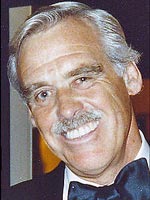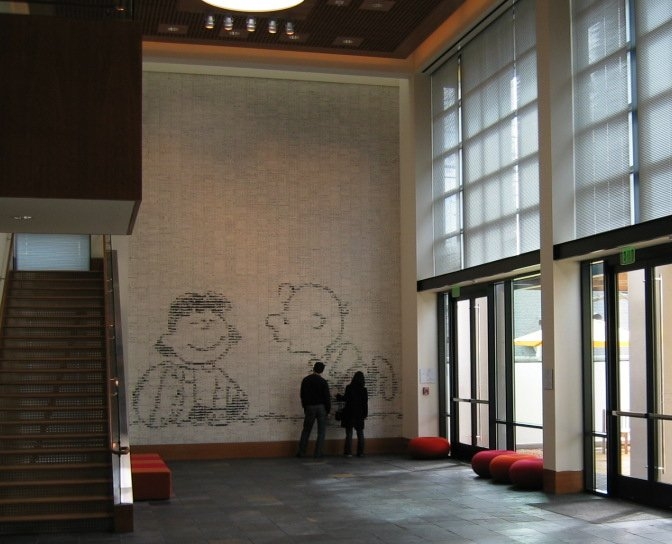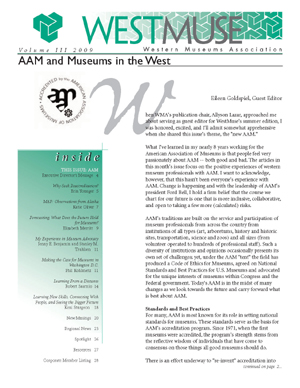By James G. Leventhal
Last spring the Western Museums Association took its newsletter WestMuse digital in two ways. The printed version became a pdf, thanks to Publications Manager Valerie Huaco and this blog got started for consistent, ongoing updates – an open forum for members, nonmembers and every once in a while friends from Australia and other countries, as a valued offering of the Western Museums Association. The value you get and give others by investing in WMA.
The next step in WMA’s transformation will be to set up digital renewals and move all of the listings to that process. And thankfully you've encouraged it. Accordingly, when a survey email was sent around by WMA Exective Director Elida Zelaya to supporters, asking if taking the newsletter digital was OK, there was a request from several members to make renewals digital, too. Thank you.
Following #wma09 in San Diego, the Western Museums Association has taken on some necessary restructuring -- to read more please see President Aldona Jonaitis' post San Diego Sun, Sustainability and Seriousness.
And so WMA Board member Allyson Lazar is now heading up the effort toward digitization. And along the way, just now she was going over the list of Corporate Sponsors. It’s a great list. Thanks again.
But as we transferred over the names from a spreadsheet to a web listing, preparing to move them into to a new web-based renewal system, we noticed that portions of the list were out-of-date. These things happen.

C. David Robinson (1936-2008)
In fact, they’re quite typical for this kind of process. You miss things. Especially when supporters pass away, and if someone is not regularly going over the notices. One of the names that was still on the WMA list was that of C. David Robinson.
The thing is, we could not let this pass without taking this opportunity to draw attention to a remarkable life that still only too recently left our midst in early 2008, and a life that shows just how rich one life can be.
As a supporter of the Western Museums Association, Robinson also represents the breadth of experience WMA stands for and, well, the indefinable character of the organization and the varied people and institutions engaged with WMA.
Chalfant David Robinson led one of those extraordinary twentieth-century lives. He was born in 1936, in New York and moved to Washington, D.C. at a young age. According to his obituary in The Washington Post (from which several details below are taken – to read the original article by Matt Schudel click here):
- Mr. Robinson attended St. Albans School and was a graduate of St. Paul's School in Concord, N.H. He received a bachelor's degree in art history from Princeton University in 1957.
- An outstanding athlete, Mr. Robinson was captain of the Princeton hockey team and participated in rowing. He competed in trials for the 1960 Olympics in crew and also played rugby.
- After college, he served as a Marine Corps officer for three years, and then entered graduate school at the University of Pennsylvania, receiving a master's degree in architecture in 1965. His primary mentor at Penn was the renowned architect Louis Kahn.

“The (building’s) scale is intended to put visitors in the shoes of the small characters who inhabit the Peanuts world," C. David Robinson, Architect
Mr. Robinson began his career in San Francisco with the firm of Skidmore, Owings and Merrill and in 1970 was a founder of Robinson, Mills & Williams. Later, he was a partner in the firm of Polshek and Partners before founding his own architecture office in 1997.
Additionally Robinson’s experience included:
- The Iris & B. Gerald Cantor Center for the Visual Arts at Stanford University
- San Francisco Museum of Modern Art
- Yerba Buena Center for Visual Arts in San Francisco
- Berkeley Art Museum and Pacific Film Archives
- San Jose Museum of Art
- Fraenkel Gallery in San Francisco
- Utah Museum of Fine Arts
- Washington State History Museum
- And designs for residences that house major art collections for such clients as Eli Broad, Frederick Weisman, Rene di Rosa, and John Berggruen
Redmond J. Barnett, WMA Board Member and Head of Exhibits at the Washington State Historical Society, remembers working with David Robinson in 1990 on the “program plan” for the Washington State History Museum – the instructions to the design architects about the size and location of each area: “David was tactful but firm, taking direction from the staff but not bashful in warning us to cut our grand ideas down to the probable budget. His experience as a designer informed his advice as a planner.”
Robinson was also a notable art collector who contributed an important collection of 150 early photographs to the National Gallery of Art in 1995, including works by William Henry Fox Talbot, who is credited with inventing the photographic process in 1839, as well as prints by such pioneers of photography as Eugene Atget, Carleton Watkins, Paul Strand, Edward Weston, Walker Evans and Robert Frank. As a a major collector of 20th-century art, he served on the boards of the San Francisco Art Institute, San Francisco Museum of Modern Art, San Francisco Planning and Urban Research Association and the Berkeley Art Museum and Pacific Film Archives at the University of California at Berkeley, among others.
Perhaps most famously, Robinson was the chief architect of the Charles M. Schulz Museum and Research Center in Santa Rosa, Calif., which opened in 2002. Speaking about the project Robinson told the Los Angeles Times in 2002, "Every design decision has been based on a single question: Would Sparky [Schulz's lifelong nickname] be comfortable here?" adding, "We have done our best to suggest the playful whimsy of his cartoon world."
And the Schulz Museum has blossomed. One of the more interesting aspects of the Museum and Research Center's work is their traveling exhibitions. Now, five years after the Museum and Research Center's founding, the traveling exhibition program that began in 2001 with Speak Softly and Carry a Beagle: The Art of Charles Schulz remains a vibrant aspect of the Museum and Research Center's offerings. The Schulz Museum now has available three exclusive traveling exhibitions that tell the Peanuts story:
- Inside Peanuts: The Life and Art of Charles M. Schulz, an in-depth exploration of Schulz’s creative process spanning his fifty-year career
- Peanuts at Bat examines the Peanuts Gang’s ill-fated baseball adventures and Schulz’s love of the game
- And To the Moon: Snoopy Soars with NASA covers the history of the Apollo 10 mission and the Peanuts characters’ role in that flight.
To the Moon: Snoopy Soars with Nasa started its tour at the San Diego Air and Space Museum this past September 2009, while WMA was in town.









Comments
James, this is a lovely tribute to a man with vision and love for museums... a fitting way to pause and appreciate where we came from, before moving forward.
Thank you for including this bit about David's life, creativity, and his important legacy in the museum community. This moving recognition is exactly why WMA continues to be an organization with an incredibly human dimension.
This is a wonderful recollection. I did not know Robinson but now wish I had. The range and passion of his engagement is s model for all of us today. Thanks.
Add new comment